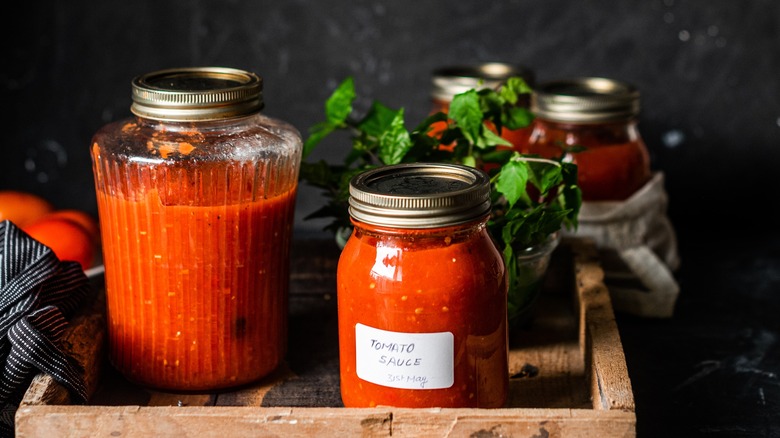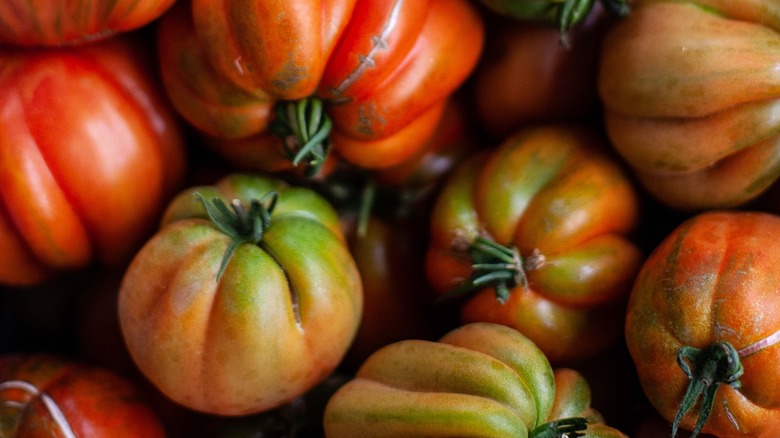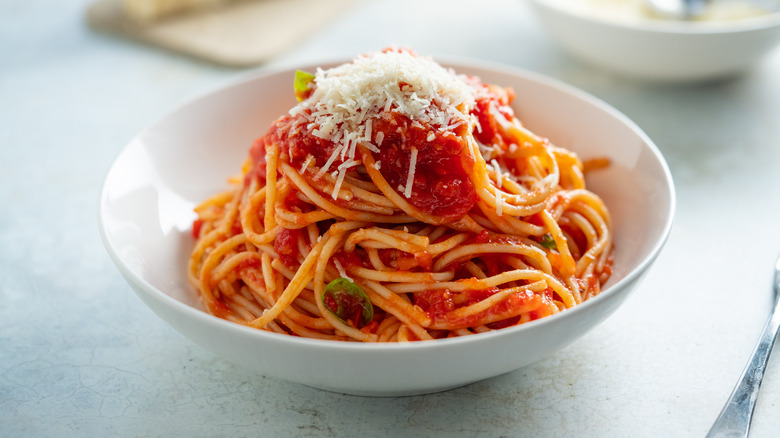Why You Should Roast Tomatoes First For Homemade Tomato Sauce
Looking for the secret to incredible homemade tomato sauce every time? If you want to take your tomato sauce to the next level, roast your tomatoes first. According to Botanica magazine, roasting tomatoes enriches the sweetness of the fruit and balances out the acidity, creating a lush texture that's perfect for homemade tomato sauce. Further, roasting tomatoes is also a great preservation technique when there is an abundance of perfectly ripe, slightly under-ripe, and misshapen or bruised tomatoes during the harvest season. You can have access to perfectly prepared tomatoes all yearlong by roasting them when they're at their optimal freshness.
Fleshy, ripe tomatoes lead to succulent roasted tomatoes in a bath of fragrant juices so keep that in mind when selecting your tomatoes. According to Getty Stewart, the author of "Prairie Fruit Cookbook," using firm tomatoes — such as Roma tomatoes or certain heritage tomatoes typically used to make tomato paste — results in roasted tomatoes that lack pan juices and may wind up a bit tough, more like a sun-dried tomato. While the flavors will be delicious, you'll need to augment your sauce with liquids such as wine or balsamic vinegar to create the perfect texture for a sauce.
Juicy tomatoes for succulent sauce
To roast your tomatoes for a tomato sauce, America's Test Kitchen (via CNN) recommends drizzling olive oil over a single layer of cut tomatoes spread on a baking sheet to prevent overly drying out or burning the delicate tomato flesh. Position the tomatoes cut-side up for the best results. Season the tomatoes with sea salt, pepper, garlic, and herbs de Provence (an aromatic mix of eight herbs and spices, including thyme, basil, rosemary, and oregano, per MasterClass). The roasting process (first at 425 degrees F, then at 300 degrees F) will enhance the flavors of these ingredients, bringing a richness to your sauce that will be amazing.
Getty Stewart, meanwhile, suggests slow roasting your tomatoes for the most caramelization and flavor concentration. She sets her oven temperature at 375 degrees F and roasts her tomatoes for 45 to 60 minutes. Stewart says the resulting roasted tomatoes will have charred bits that add a lovely caramelized smokiness to your sauce, and cautions against adding basil to the roasting pan because basil is delicate and will burn, adding a bitter taste to your tomatoes.
For a different approach, consider popping the baking pan under a hot broiler for 10 minutes to sear in the aromatics and crisp the delicate skins of the tomatoes before slow roasting, via Kitchn. Broiling will add a unique textural component to your tomatoes and sauce. And as the outlet notes, heat draws out flavor.
Roasted tomatoes for sauce and garnish
Once your tomatoes are roasted and cooled, spoon them into a food processor or blender for a smooth sauce. The Spruce Eats suggests using a food mill to prep your roasted tomatoes. We recommend taking your sauce to the next level with secret ingredients like anchovies and fish sauce to add complexity and umami. Salty hard cheeses like Parmesan and pecorino romano bring out the savory flavors in any tomato sauce. A drizzle of balsamic vinegar is a great way to finish your sauce and elevate the amazing roasted tomato flavors.
Roasted tomatoes are also a delectable addition to salads, pasta, and pizza, and served alongside hummus with a warm pita. The tomatoes also work great in a vinaigrette. Spread roasted tomatoes on slices of toasted Italian bread and top with basil, salumi, or burrata cheese for perfect bruschetta. Top braised salmon, grilled meats and vegetables, and piping hot quiche with freshly roasted tomatoes. No matter how you serve them, roasted tomatoes can enhance most any dish and can make your homemade tomato sauce that much more flavorful.


